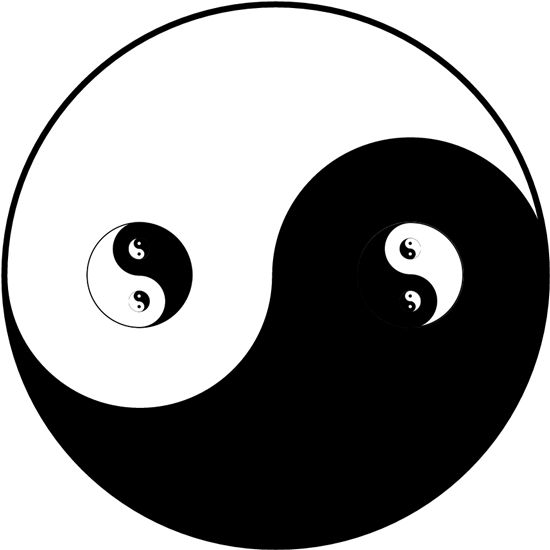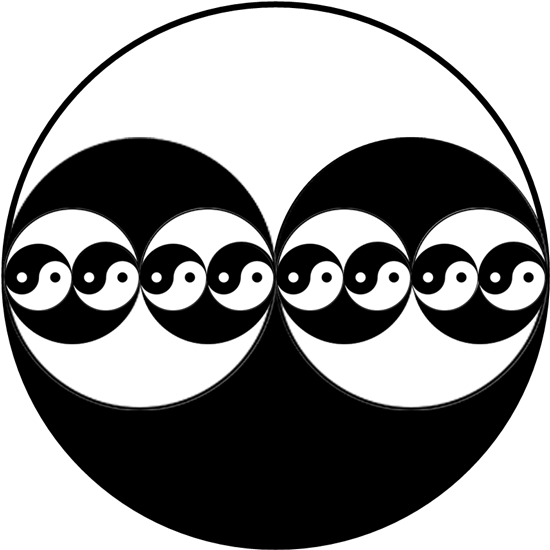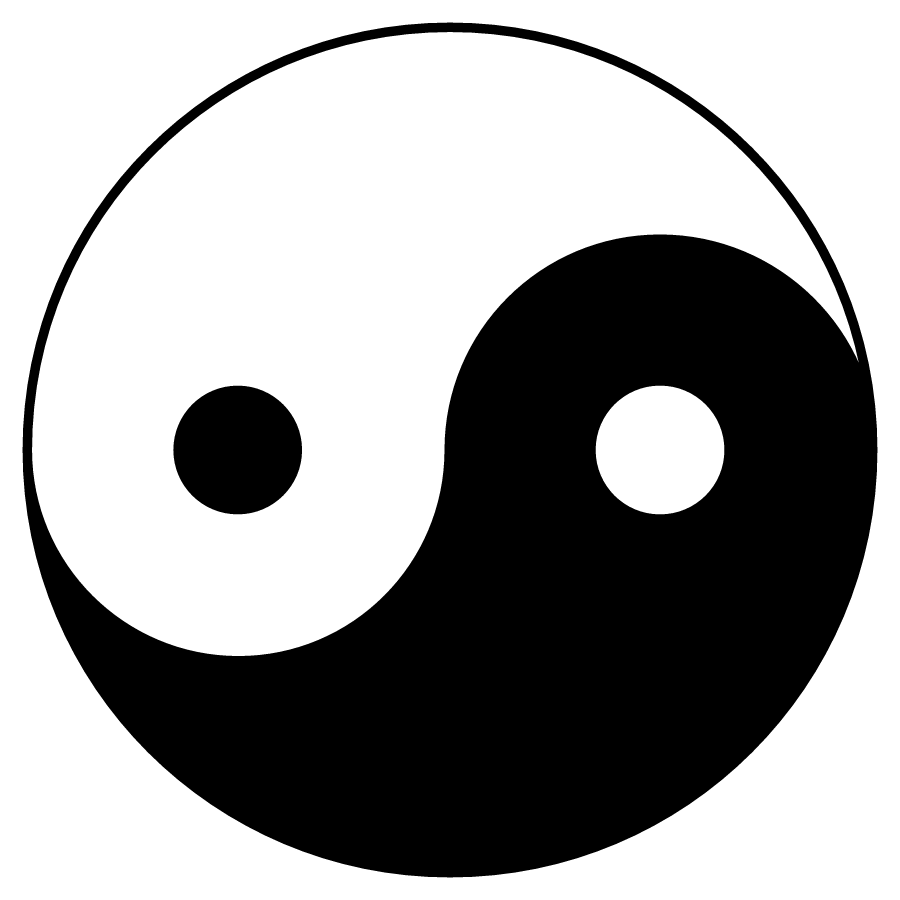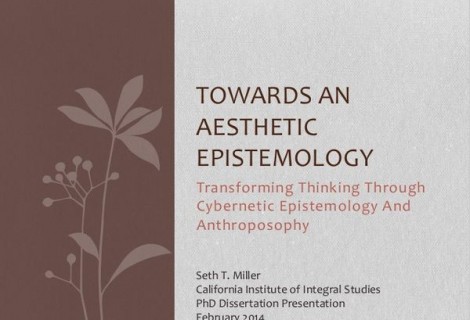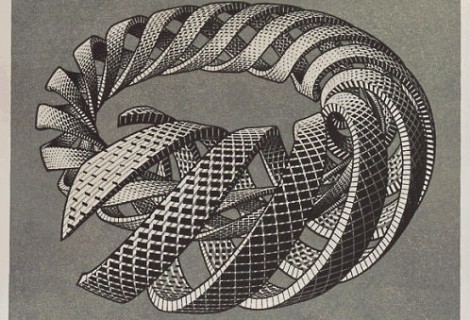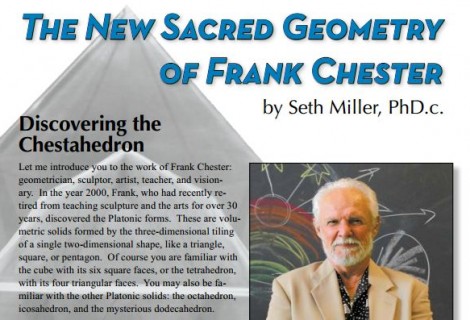An Esoteric Guide to Spencer Brown’s Laws of Form #3
« Previous Page | 1 2 3 4 5 | View All | Next Page »
(New readers will want to start with the first installment.)
We ended the last installment noting that the first distinction must be of distinction, but this must be considered as a complex, recursive creation and simultaneous crossing of a boundary that is just precisely the boundary between that very activity of its creation and the fact of it as created.
To get at this another way, we can point out that the Glanville has actually hit on elements in this direction already, but (it seems) hasn’t quite put it together in the same way. Remember that the whole time we have been talking about the first distinction we are also talking about “the observer”, which we could call a “self”. It may even be worth revisiting some of the above text with that implicit translation in mind. I remind you of this because, Glanville, in his essay The Self and the Other: The Purpose of Distinction, is exploring solutions to the problem of infinite regression that arise when the mark doesn’t distinguish itself from its value, and he uses “self” and “other” to hold the logic of “mark” and “value”, which is perfectly fine.
Glanville notes that we have a set of relations that are implicit in each other: that between self and other: “the fundamental distinction between self and other [read: between the mark and its value] cannot be more fundamental than the distinction of the self, nor can it be less so: another circularity, another reduction of hierarchy” (p. 3).
Except that this isn’t a reduction of hierarchy. It is actually the very foundation of all hierarchy; this is Glanville’s mistake (if it could be called such): the misidentification of circularity with the collapse of hierarchy. The restoration of this feature is precisely what is needed to move forward, and Glanville actually gets there, but doesn’t quite (it seems) recognize the fact.
He points out that the distinction between self and other is not complete, but actually implies more: the self as self, and the self as other. This is to say, the mark as a mark, and the mark as the value it indicates. But this is a reciprocal relationship, where we also note an other as self. He has a useful shorthand formulation which is probably worth mentioning, because it helps make the point more clearly. He takes a capital letter to refer to the recursive nature of self, it is self-defining (but, as we shall see, also other-defining), and a lower case letter to refer to the objectified, the not-self (but only, and always, for self).
“(A, A) indicates the self of A “observing” itself as a self
(A, b) indicates the self of A “observing” b as other, that is, b as another to A’s self :::: etc.” (p. 2)
Remember that “observing” here is the same as the mark (referring back to GSB), the same as the distinction; it is the form. Now we get to the juicy bit. He points out:
“Thus, the distinction between self and other implies the distinction of the self, and the distinction of the self implies the distinction between self and other. And, because the roles of what are called the self and the other are, in effect, to each of them as a self, the same, and because each “validates the other”, it is necessary that that which the so-called self refers to as the other, is, to its self, a self in its own right: ie, it distinguishes itself, and is thus distinguishable to another (the original self): again the circularity. Thus , we acquire an (aesthetic) symmetry.” (p.3)
Now, to insert an esoteric aside, before we continue unfolding this subtle issue, we can note that what this means is that, all others are selfs, all selfs are others. This is nothing other than the esoteric principle that BEING is all that is: if it is “out there” as an object, it, also, has an interiority, a “self”, which we are recognizing here from a very very odd starting point.
In other words, the ontology of a being is always the ontology of ALL being; the act of self-distinction is always simultaneously an act of other-distinction, and vice-versa. This, esoterically, is the principle of the cosmological Christ, the I-in-Thou/Thou-in-I. We shall see how this flows naturally from Glanville’s own formulation.
To fill out his method:
“The self distinguishes the self (A, A)
In distinguishing the self (A), the self distinguishes another (A, b)
The other distinguishes itself as itself (B, B)
The other distinguishes the self as an other (B, a)
Whether or not an other can distinguish an (other) other as an other, it appears we may not know, for we can never be another. Thus, (a, b) and (b, a) seem, for the moment, to be meaningless statements.” (pp. 3-4)
The key, however, is in his recognition that: “the distinction between the self and the other and vice versa is, itself, a distinction. Let us call this distinction C.” (p. 4)
Now, he doesn’t recognize it explicitly, but here he has implied exactly the principle that is required for the whole thing to come together: the actual crossing, simultaneous to its actual distinction, of the boundary that separates N and N+1 levels. This is a second-order distinction, the distinction of a distinction. But the whole point is that the second-order distinction is recursive with respect to the first-order distinction: they are co-generative and co-incident.
In other words, all three, A, B, and C, can be not REduced, but INduced, (or some other new word) to a SINGLE, COMPLEX UNITY. This paradox is equivalent to that of the mystical “three-in-one/one-in-three” of Christianity, and although it is synchronistic, the choice of the letter “C” for this is fortuitous.
So Glanville can now say:
“In order for the self (of the first instance) to distinguish the other (A, b), and the other (of the first instance) to distinguish the self (B, a), they do so by drawing a distinction, itself a self to itself (C, C). So, for instance, the distinction between the self and the other (A, b), is made by drawing the distinction that distinguishes them, C – that is (C, C) – which, although a distinction like any other distinction, has the role of distinguishing between the self A (A, A), and the other B (B, B) as other (b) to the self (A), which, thus allows the transfer across: the making of the self of the other available as an other to the other self: that is, C (C, C) transforms B (B, B), for A (A, A), into b so that (A (A, A), b), and, reciprocally, (B (B, B), a). The role of the distinction C is that it allows a self to say of an other that it is an other. It may be taken, thus, that the purpose of the distinction C, for A and B, is that it permits / creates this role change, this transfer.” (p. 4)
Now here is the place where an esoteric background is helpful. Glanville notes, following his own reasoning, that “this distinction, C, is to both A and B, itself an other. Thus, to A, C is c (A, c), and, similarly, to B, (B, c). We once again need a role transforming distinction, another distinction, D (D, D), and so on: the regression is apparently clear, although, as Varela and I have indicated [3], this formal regression leads to a logical re-entry, and so is not quite so daunting as it might normally be.” (p. 4)
But this whole business with D (D, D) and so on is simply not necessary. Why? Because there is no hierarchical regression: at any stage the infinite regression is the same as the single instance. Again, this is an esoteric mystery: that of immanence AND transcendence. This is the dual face of the ultimate: the Sufi wahdat al wujud. The single existence of C is all that is required. This “transfer function” is a necessary part of the primal distinction; it is the missing link between the mark and its value, that would otherwise create only endless duality. In other words, all distinction has a threefold nature: Self, Other, and the Self-Other Relation (or we can equally say: mark, value, and the act of distinguishing them).
Of course, this is exactly what has been known throughout the whole of esoteric history. We can point out that alchemically we have: Self=Sulfur, Other=Salt, and Transfer=Mercury, or in Esoteric Christianity: Self=Father, Other=Holy Spirit, Transfer=Son. This goes on endlessly, which is precisely the point. Returning to the very conditions under which GSB relates the Laws of Form, he mentions that
LoF p. 1
- There can be no distinction without motive, and there can be no motive unless contents are seen to differ in value.
We have seen this already, but now we can see it in a new light. As before we have:
motive –> distinction –> (value) –> motive
Now we can recognize this as the very same threefoldness that is inherent in the primal form. So:
motive –> distinction –> (value) is also:
self –> other –> transfer function
will –> thinking –> feeling
sulfur –> salt –> mercury
and also, more primally:
activity –> content –> (the needed crossing of the boundary, not completely integrated in GSB, found, but unrecognized as such, by Glanville), and lastly:
Father –> Holy Ghost –> Son (alternate versions occur: see Hall’s Secret Teachings of All Ages, Forgotten Books, p. 477)
Hopefully, despite the admittedly difficult nature of this whole commentary, things might be starting to come together, that is to say, they might be starting to be confused.
So how can we express the mark in terms of its manifold unity? Of course, we can use anything as the mark, but this doesn’t mean that all marks are equal. GSB’s original mark is the upside-down, reversed “L”, which clearly does not embody the characteristics we have discovered for the first distinction. We need something that, as a mark, embodies the complex nature of the primordial distinction of distinction. GSB, in LoF, also uses a circle as a mark, which is better in that it indicates recursivity, but it is still too simple. Now, would it be any surprise at all that the kind of mark we are looking for has been known for millennia? And that this mark would have as an explicit meaning “supreme ultimate” and “primordial universe”? I refer, of course, to the taijitu, the symbol, the “yin-yang” symbol, which I have modified a bit to be more explicit about the relations it expresses:
We can also indicate the same set of relations with this modified form, which is actually more “technically” accurate, but harder to read visually:
Here we have a mark that displays the qualities we know the mark must have: it is recursive, it is a complex whole, it defines itself, and most importantly it expresses, as well as any visual symbol can, the necessity of the mark to make a boundary that it then crosses. This last is what implements the most important feature of the primordial mark: it has to distinguish levels N and N+1, and it has to do so in a recursive way. Of course the symbol itself is static, but note: one cannot literally “see” the whole image all at once. Your eyes bounce back and forth, and as they do so, they continually cross the boundary that is the whole of the form (the self-defining boundary, which is all this form is). But then you realize, in looking at the smallest “dot” in the form, that it doesn’t appear to be subdivided again. This, of course, is a limitation of the medium, not the symbol, and suddenly the symbol has initiated an activity of continued crossing in your thinking. The actual drawn mark cannot directly be the activity of its own drawing, but it can indicate this activity as it occurs in you–actually. And then you are led to the realization that the whole symbol itself sits in a white space… which of course means that there is, ultimately, no reason to have the form so overtly indicated over many levels, because all that is needed is the original form:
This is exactly the feature we would expect, actually require, of a form that fulfills its promise of being defined only by itself. That is to say, looking at the first, more explicit form, we see that every stage is implied by, and implies further, every other, so we really can “reduce” the form to the more simple version, because that is all that is needed to generate the entirety of the form and its activity.
So we can, in a very direct and precise sense, call this form, the taijitu, the form of the form. Implicit in this saying is again the creation and crossing of the boundary N and N+1. It would actually be helpful to distinguish our English: “Form” with a capital “F” can be taken to refer the N+1 level, the level of the coming-into-being of the “form”, with a lower case “f”, which denotes the form as expression, or rather, as expressed (pressed out from itself). In this sense, then, the taijitu is the Form of the form, and we can then use, as a form (lower case “f”) something like GSB’s “cross”, the upside-down, reversed “L”.
Of course it bears pointing out that the taijitu is a fractal, and that this is precisely what allows it to embody the characteristics we are after for the primordial form. Or rather, it would be more accurate, perhaps, to say that what it means to be fractal goes back to the nature of the first distinction as we have discussed it. In other words, that so much of the universe shows up as the expression of fractal patterning should not take us by surprise, but should be expected. It is no wonder that the Mandelbrot set is referred to as, and now we can see something of the literal meaning of this phrase, the “thumbprint of God”.


